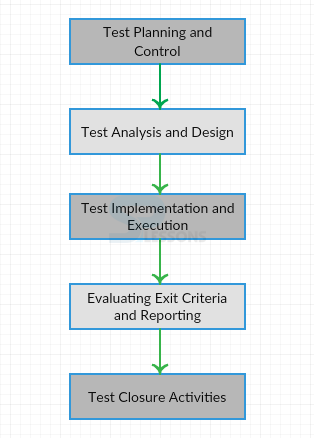 Description
Description
Software Testing Fundamentals is the process that start from
Planning and end with test closure activities. And these Fundamentals Of Testing is a procedure that test the engineer for proceeding with some of the intellectual factors that includes the execution process of each and every tasks.
Following are the Software Testing Fundamentals topics that are covered in these testing process,such as:- Fundamentals
- Fundamental Test Process
- Psychology Of Testing
- Testing Principles
 Description
Description
Software Testing Fundamentals are the basics concepts in software Testing for performing all the test cases. And these fundamentals will gives a brief idea about the testing process.
A person action that produces a false output.
A fault in a system that can cause the system to fall to execute its task.
Diversion of the component from its expected transmission.
A group of input values, requirements to execute the Application.
The rate to which a system meets the customer satisfaction.
A action necessary for a user to clarify a trouble.
If the system does not create any problem to the user is known as Reliability.
Fault is a state located inside the system.
 Description
Description
Fundamental Test Process is a analysis of testing action throughout the life cycle. And Principles are nothing but the
rules that have been implemented by test engineer. There are seven standard principles in Testing.  Description
Description
Test Planning defining the overall strategic and skillful objectives of testing, as well as discovering and specifying the specific test activities required to satisfy those objectivity and the general mission of testing. In test control we continuously compare actual progress against the plan, adjust the plan, report the test status and necessary deviations from the plan, monitor test activities.
 Description
Description
In this the first step is to review the test basis, then lock the expected data. Identify the test conditions, using those test conditions design test cases, set up test data and test environment and finally create tractability matrix.
 Description
Description
In this, procedures will be specified. During test implementation,
- Finalize, implement and prioritize the test cases.
- Identify and create specific test data, which can take the form of inputs, data resident in database and system configuration data.
- Develop and prioritize test procedures.
- verify the test environment has been set up corretly.
- Execute the test procedures manually.
- Compare expected data with actual data, observe the results.
- Log the outcome of test execution.
- Analyze the incidents in order to establish the there cause.
- As necessary, repeat test activities when actions are taken to resolve deviation.
 Description
Description
During evaluation of exit criteria and reporting,
- Check the test logs gathered during test execution .
- Judge if more tests are needed.
- Write a test summary report for team member.
 Description
Description
In test closure, data should be collected from completed tested action to combine involvement, test ware, facts and numbers.
During test closure,
- Check which planned deliverable have been delivered.
- Make sure that all incident reports are fixed.
- Report the approval of a system.
- Complete and file test dataset.
- Hand over the testware to the maintenance organisation.
- Use the information gathered to improve test wisdom.
 Description
Description
The mindset is quite different from the mindset that have a business analyst, system design, architect, database administrator, must bring to creating the work products involved in developing software. To be most effective at finding defects, a tester needs the right mindset.
Good testers are curious about why systems behave the way they do and how system are built.
Good testers are expected to find defects and failures.
Good testers couple this professional pessimism with a natural inclination to doubt the correctness of software work products and there behaviors.
Good testers not only know a defect, when they see one, they also know where to look for defects.
Testers should have good communication skill to explain the results.
 Description
Description
Principles are nothing but Rules to be implemented by Test Engineer.
- Exhaustive Testing is Impossible
- Absence of Error Fallacy
- Testing Shows Presence of Defect
- Testing is Context Dependent
- Defect Clustering
- Early Testing
- Pesticide Paradox
- Software Testing Fundamentals is easy to plan Software Testing Process.
- Testers should have good interpersonal skills.




